ឈឹង Chhing (Cymbals)
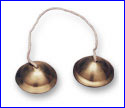
Chhing are cymbals. Worldwide, there is a great variety of cymbals: hand cymbals, finger cymbals, flat cymbals, forked cymbals, plate-shaped cymbals, bowl-shaped cymbals, and cup-shaped cymbals, etc. In Israel, for instance, cymbals were found in temple orchestras as far back as 1,100 B.C. Metal cymbals were found in Egypt in the eighth century B.C. In ancient and modern Asia, two types of cymbals have been distinguished: the broad-rimmed with a small central boss, and the narrow-rimmed with a large central boss. Both the broad and the narrow-rimmed versions appear on the Hindu-Javanese temple sculptures of Borobudur (about A.D. 800). They are also mentioned in the annals of the T’ang dynasty of China (A.D. 618-907) as having a prominent part in the theater.
In Cambodia, we find the chhing (small bowl-shaped finger cymbals) of thick and heavy bronze, with a broad rim. They are made of an alloy (mixture of iron, copper, and gold) mixed with bronze. They measure about 2 inches in diameter and are joined together with a cord, which passes through a small hole at the apex of each one of them. Each cymbal of the pair is held in one hand and the two are struck together. The chhing are the timekeeper of the ensemble. While cymbals, in general, are used for various occasions (ritual, martial, theater, and at war), the Khmer use them purely in theater, dance, and music contexts. They produce open and closed sounds — chhing and chhepp — marked respectively by the signs (o) and (+) in transcriptions. To produce the open sound — chhing — the cymbal in the right hand hits the other in the left with an outward sliding motion, while the closed sound — chhepp — is produced by hitting both cymbals and holding them together; thus dampening the sound. The chhing and chhepp or open and closed sounds of the chhing mark the unaccented (o) and accented (+) beats in the actual music making.
ឃឹម Khimm (Dulcimer)
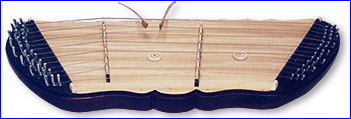
Khimm is a chordophone belonging to the board zither family. Today, board zithers can be found in many places under different names such as Persian santir, Sovietchang, Indian santoor, Korean yangum, Swiss hackbrett, Iraqi santir, Chinese yang chin, Hungarian cimbalom, Thai khim, and Khmer khimm. It is believed that the present board zithers are developed from the Middle Eastern qanum.
The Khmer khimm is believed to be brought over to Cambodia by the Chinese along with their theater. It has been adopted and modified to be used in the Khmerbasakk theater. There are two sizes of khimm used in the basakk ensemble: khimm tauch (high-pitched hammered dulcimer) and khimm thomm (low-pitched hammered dulcimer). While the former plays the melodic line, the latter plays a reduced and counter melody. Today, the khimm tauch, in particular, is commonly used in the mohori and kar ensembles as well.
ខ្លុយ Khloy (Bamboo Flute)

Bamboo flutes are commonly found throughout the world, where bamboo is accessible to make the instruments. They are one of the oldest musical instruments, perhaps as old as the human race itself. The Chinese, for instance, date their bamboo flute called dizi back to more than 7,000 years ago. In Cambodia, the khloy is an end-blown vertical flute, made of several kinds of bamboo (dak mai, ping pung, or pork), wood, plastic, or metal with a length of 15 inches and a diameter of approximately 1 inch. It is commonly known as a duct of fipple flute. It is used in the mohori and kar ensembles, or as a solo instrument. In Cambodia’s countryside, [you can often find] a boy or a man under a straw hut or on the back of his water buffalo playing a bamboo flute while watching his cattle, keeping them from eating the rice paddies.
The tone of the khloy is produced by blowing into the duct at the tip of the instrument. It has a range of approximately two octaves from D to C. There are two sizes of khloy — the small called khloy aek and the large called khloy thomm. Khloy thomm, meaning “large-sized flute,” is actually larger in size than the khloy aek. The khloy thomm is not commonly found in the current practice.
The khloy does not have keys like the Western metal flute, but six (some have seven) fingerholes and a thumbhole (some do not have this hole). Some musicians prefer a membrane and therefore another hole toward the upper part of the instrument is drilled. The membrane is made of either rice paper or bamboo skin, which provides a bright and crisp sound.
គងវង់ធំ Korng Thomm (Low-pitched circular frame gongs)
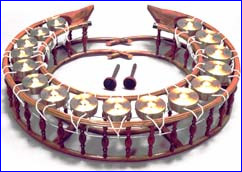
Korng vung thomm or korng thomm means “a large circle of gongs” (low-pitched circular frame gongs), which is modeled on the same principle as the korng tauch, but larger in size — both the gongs and the frame, which measures approximately 48 inches from side to side. Since both the korng tauch and korng thomm overlap in range, those pitches, which are identical, are likely to be the same in size.
The korng thomm plays a line almost identical to that of the roneat thung, except it dwells more steadily on the pulse.
រនាតឯក Roneat Aek (Bamboo / wooden xylophone)
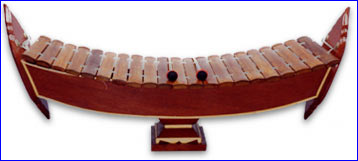
Roneat means “xylophone;” aek means “one, first,” or “leader.” Therefore roneat aek means “first xylophone” or “leading xylophone.” It is also known as roneat rut, which literally means “running xylophone.” The roneat aek or the roneat rut is considered to be the leading instrument because its role is to start a piece and to cue the others. Many Khmer musicians think that the roneat aek plays the melodic line. In fact, it plays variations of the melody, which is usually carried by a vocalist or a sralai player. Stylistically speaking, the roneat aek is played in octaves, less commonly in fourths or fifths. The twenty-one bars of the roneat aek provide a three-octave range, but because it is played in octaves (between the left and right hands), it only covers a two-octave range.
The resonator of the roneat aek is approximately 46 inches long. It stands about 22 inches high, atop a 5.5 inch square base. The top edges of the resonator beneath the bars are padded to accommodate the bars when they are taken off the hooks when the instrument is not played. Some models are artistically and richly carved and inlaid with mother-of-pearl, ivory, or bone.
The roneat aek has twenty-one thick bamboo or hard wood bars, which are cut into pieces of the same width, but of different lengths and thickness. The lower the pitch, the greater the length, and the higher the pitch, the thicker the bar. Theroneat aek bars are approximately 14.75 inches (lowest pitch) to 10.5 inches (highest pitch) in length. The width of each bar is approximately 1.75 inches, whereas the thickness is about 0.5 inch.
The player strikes the bars with two mallets whose heads are thick discs. The mallet handles are about 16 inches long. The soft discs are approximately 1.75 inches in diameter and 1.25 inches thick. The hard discs are 1.5 inches in diameter and 1 inch thick.
រនាតធុង Roneat Thung (Large xylophone)
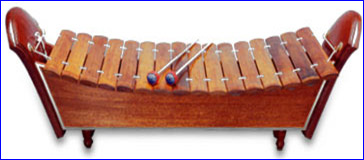
The roneat thung is better called roneat thomm (large or big xylophone), because its resonator and bars are larger and longer, and its sounds, therefore, are lower than the roneat aek. This rectangular trough-resonator measures about 50 inches long supported by four short legs. While the end-pieces of the roneat aek and theroneat daek are flat and straight, the roneat thung end-pieces are curved slightly outward. The roneat thung has sixteen bamboo or wooden bars, measuring about 18.75 inches (low pitch) to 15.25 inches (high pitch) in length. The width of the bars (low and high) is approximately 2.5 inches and the thickness of both is about 0.75 inch. As the materials, which are used to make the bars, are the same as theroneat aek, the same tuning blobs are also utilized. Like the roneat aek, the roneat thung bars are suspended with two cords running through holes in each bar and placed on two hooks at each of the two curved end-pieces that are connected to the resonator.
Only soft mallets are used to play the roneat thung, either indoor or outdoor. While the mallet handles of the roneat thungare about the same length as those of theroneat aek, their disc are larger and thicker. Each measure approximately 1.75 inches in diameter and about 1.5 inches in thickness. The range of the roneat thung overlaps that of the roneat aek, one octave lower. Due to its stylistic playing, the sixteen bars cover a range of music of over two octaves, a range that is wider than that of the roneat aek. The role assigned to the roneat thung is to counter the melody. The roneat thung plays a line almost identical to that of the korng thomm, except in a lak (vivacious, funny, comic) fashion.
សម្ភោរ Sampho (Small double-headed barrel drum)
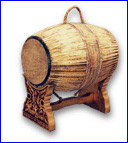
The sampho, a small double-headed barrel drum, is considered by Khmer musicians among the most important Khmer musical instrument, having a sacred significance. In fact, it is a spiritual instrument. It was carved in stone on various walls of the Angkor temples, and has maintained both its sacred and ritualistic functions as well as purely entertainment roles. The sound of sampho is produced by the vibration of a stretched membrane when being struck. Its body is made of several kinds of wood (khnaor, kakah, raing, or beng) with a bulge in the center and a gradually tapering shape at both ends. Throughout its entire length, the solid piece of wood is hollowed out and covered with calfskin and tightened with gut or sometimes rattan strips. On top of the center bulge, the gut or rattan strips are woven into a handle for easy carrying. The sampho has a length of approximately 19.5 inches and a height (including its attached stand) of about 20 inches. The center bulge measures about 14 inches, while one side is 11 inches and the other 10.
The player hits both heads of the sampho using his hands. Because it is intended to produce a lower and higher tone on each head, this drum is constructed so that one head is larger than another. The larger head provides a lower tone, whereas the smaller gives a higher pitch. The heads, the centers of which are painted black, are tuned with tuning paste called bay sampho (rice for sampho), which is a mixture of cooked rice mashed into a thick paste with ashes from burnt branches of palm or coconut midribs. This is done to give the drum its desired pitch and sound. The white and soft part of new bread will also serve the same purpose as cooked rice. In the United States, we have experimented with children’s play dough and cream of wheat, but we have found that Fun Tak is the best material for this purpose, for it has just the right consistency for the sampho. The thicker and heavier the paste, the slower will be the vibration of the parchment, and likewise deeper the tone will be.
The sampho is mostly used in the pinn peat ensemble as a lead instrument, and is especially known for its accompaniment to the solo playing of the sralai as head in the free-style boxing piece and Salauma. The sampho has a variety of rhythmic patterns designed for specific pieces or types of accompaniment. For instance, when used in an ensemble without dance, the sampho uses a set pattern of muoy choan (one-level rhythmic pattern) of eight-beat cycle, or pi choan (two-level rhythmic pattern) of a sixteen-beat cycle depending upon the piece. When accompanying a court dance, masked play, or shadow play performance, thesampho uses a special pattern known as laim (dance), which is designed precisely for the piece it accompanies.
The sampho controls the tempo and regulates the pre-established rhythmic cycles. Therefore, it is considered to be the leading instrument in the pinn peat ensemble, as well as the instrument of the krou (teacher). Most Khmer musicians regard thesampho as a simple instrument; easy to play, and thus, neglect it. This attitude and the oversimplification of rhythmic interpretation have moved them to play just a simple rhythmic pattern for almost every piece.
ស្រឡៃ Sralai Thomm (Quadruple-reed shawm)
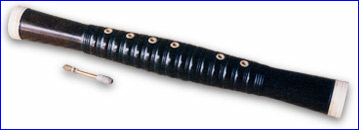
Sralai is an old Khmer quadruple-reed shawm. Scholars who write about this type of instrument often refer to it as an “oboe.” Its origin can be traced back to at least the Angkor period. On the walls of the Angkor temples, along with other musical instruments, the sralai was carved. It is used in the pinn peat ensemble to accompany the court dance, masked play, shadow play, religious ceremonies, and boxing events. There are two sizes of sralai — sralai tauch (small) and sralai thomm (large) — and another flared end called sralai klang Khaek or sralai Chvea(shawm of Javanese origin) used in the skor chhneah (klang Khaek) ensemble.
The body is made of hard wood (kakaor, beng, neang nuon, or ivory). It is important to mention that the sralai maker is very conscious about the wood he uses to make the instrument. When cutting a tree, the maker marks which end is the top and which is the bottom, as constructing an instrument upside down will make it hard to blow. In other words, the end of the sralai where the reed is inserted must be the top end of the tree.
The body of the sralai tauch and sralai thomm is made in a bulging shape at the center and an outward flare at both ends. The inside is hollowed out in a slightly conical shape the entire length of the body. Around the center bulge, sixteen pairs of rings are carved, in between which six fingerholes are bored — four in one group on the upper end and two in another on the lower — separated by a noticeable space. These rings are shaped for beauty and attractiveness, as well as to help keep the fingers from slipping. Spaces (between the two groups of fingerholes mentioned above) between rings are useful as they serve as a measurement for the length of the reed. The body length of the sralai tauch varies from 12.5 to 13 inches, with a diameter of each end of approximately 1.5 inches. The length of thesralai thomm varies from 16 to 16.75 inches, with a diameter at each end of approximately 1.75 inches.
The reed has two parts: the tube and the tongue. The tube is made of bronze, brass, silver, or sometimes gold. It is tapered — the end that fits into the top of thesralai is a little larger than the other end to which the tongues are fastened. This larger end is wound with thread for a tight fit when being inserted into the instrument. To play, the entire reed (tube and tongue) is placed in the mouth with the lips resting against the sralai. The reed is made of palm leaf cut into four little tongues and fastened to the tube with thread. The length of the sralai tauch reed is approximately 2.25 inches, whereas the reed of the sralai thomm measures approximately 2.75 inches.
A complete formation of the pinn peat ensemble includes both the sralai tauch andsralai thomm. This practice, however, can be found more often in the village and the Royal University of Fine Arts traditions, when accompanying the lkjaon kjaol(masked play) and lkhaon smaek (shadow play). In the palace, only the sralai thomm is used. Sometimes, it is even replaced by the khloy (duct flute). The sralai tauch takes a solo role in the situation when two sralai are used. However, when only one sralai is needed, the sralai thomm is preferred over the sralai tauch, due to its relative range to the ensemble.
ថូនរមនា Thaun-Rumanea (Drum)
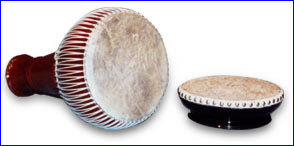
Thaun, a goblet drum, is similar to the skor arakk, except it has a shallower head and a slimmer body. The body is made of clay or wood. Its head or membrane, made of calfskin, goatskin, or snakeskin, is laced to the body by means of leather thongs, rattan strips, or nylon.
It is used as part of a two-piece drum set in the mohori ensemble. In performance, the player places it on his right lap and strikes it softly with his bare fingers and hand. The thaun carries alternate patterns to go along with those patterns played on the rumanea.
ទ្រអ៊ូ Tror Ou (Low-pitched two-stringed fiddle)
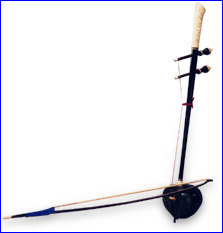
Tror ou is a low-pitched two-stringed fiddle. Its two strings are made of silk, gut, nylon, or metal, running over a bridge made of bamboo, wood, bone, ivory, or seashell. The resonator, varied in size, is made of coconut shell covered with snakeskin or thin and light wood roluoh or spung. The dried coconut shell is carefully selected; one which has the shape of an elephant’s head is most preferable. Many are found with resonator boxes carved into beautiful designs. The neck is 35 inches long. A bow hair made of horsehair, palm fibers, or fine nylon is placed in between the two strings and is not detachable. The tuning of this instrument is C-G.
ទ្រសោតូច Tror So Tauch (Medium high-pitched two-stringed fiddle)

Tror so tauch (medium high-pitched two-stringed fiddle) is similar to the tror chle, except it is bigger. Its resonator is 3.5 inches in diameter and 5 inches in length. The neck is 35 inches long. It is used in the arakk, kar, mohori, and ayai ensembles as a leading instrument. The tuning of this instrument is G-D.
Tror so tauch resonators are made of bamboo or wood covered with snake or lizard skin. Both use two metal strings, in between which runs a bow hair made of horsehair, pineapple fibers, or thick nylon threads.
ស្តាប់ឧបករណ៍ទាំងអស់ប្រគំជាភ្លេងមហោរី Mohori Ensemble from instruments
About the Studio Session
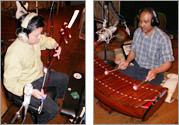
Recording sessions for “Conduct a Cambodian Ensemble” were held at Bias Studios in Springfield, Virginia in May 2003. Musicians Dr. Sam-Ang Sam and Ngek Chum recorded each instrument in succession to a multitrack recorder. Following recording, the volume level of each instrument was adjusted during playback in order to mimic a mixed sound similar to a live, traditional Cambodian ensemble.
Technical Notes: All instruments were recorded and mixed digitally using the Mark Of The Unicorn Digital Performer Hard Disc Recording System and Digidesign Pro-tools HD 192. Reverb and compression were used sparingly.
Source: Sam, Sam-Ang. “Musical Instruments of Cambodia.” Osaka: National Museum of Ethnology, 2002.




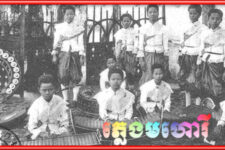
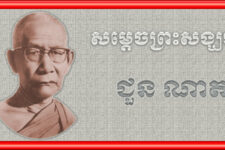
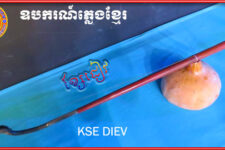
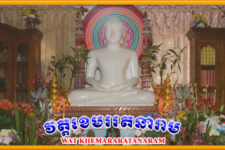
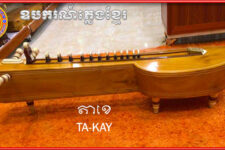

 មើលថ្ងៃនេះ: ២,១៦១
មើលថ្ងៃនេះ: ២,១៦១